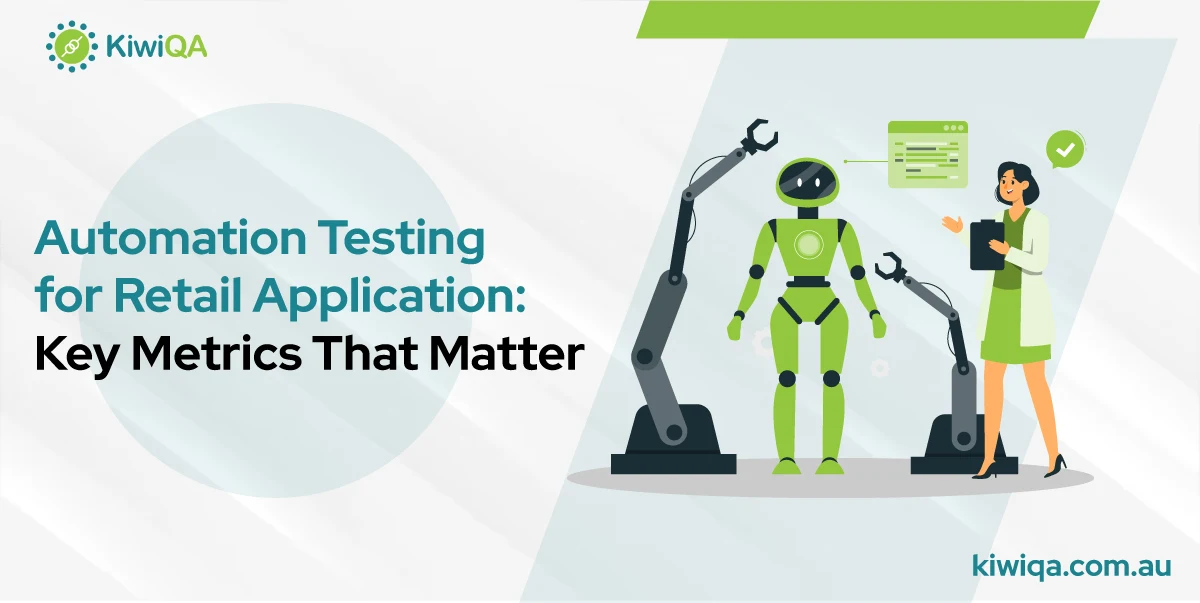Automation Testing for Retail Application: Key Metrics That Matter

 KiwiQA
KiwiQAAs per the current landscape, automation testing has revolutionized from an optional choice to a necessity for QA pipelines. Rapid retail software deployment and updates are essential to match the evolving customer needs. The retail business is now adopting new technologies and strategies across the board from online to in-store shopping.
From inventory management to CRM, the industry integrates smart techniques to rule the business landscape. Test automation helps 72% of profitable companies with their deployment cycle. Most of the stakeholders now understand the importance of automation value, but they are thinking about it due to the upfront financial investment.
With the establishment of multiple organizations, selecting the perfect automation testing tool is a necessity. It is necessary to understand the thorough metrics so that your QA team can track bugs and resolve them to deliver error-free apps. The blog aims to understand the crucial metrics related to the automation efforts. Read to know what metrics are involved in Retail Software Testing Services and how they matter.
Test coverage helps teams make sure that important features and code paths are evaluated by quantifying the scope of the program that automated tests evaluate. It is frequently computed by dividing the number of functions covered by tests by the total number of features in the application.
Test coverage measurement enables us to apply critical thinking techniques and spot possible places where our CI/CD process needs to be improved. We can be more certain that the features we are releasing won’t negatively impact our product by identifying and improving regions with low test coverage.
Test coverage is essential for software quality and dependability since it lowers the possibility of undetected flaws, increases product trust, and helps find testing gaps. Test coverage helps identify any problems early in the development process and makes fixing them simpler and less expensive by guaranteeing that a sizable amount of the application’s code is run during testing.
The duration of automated test execution is monitored by this statistic. It demonstrates the test suite’s efficiency and speed. By optimizing test execution time, teams may reduce the whole testing cycle and receive feedback on the software’s quality more quickly. By tracking test execution time, one can find slow-running tests, resource-intensive test cases, or infrastructure bottlenecks that need to be fixed.
It speeds up the testing procedure, giving software quality feedback more quickly. It enhances time-to-market by facilitating speedier problem identification and resolution. It shortens the testing cycle time, which maximizes resource use.
The speed and effectiveness of retail software development are directly impacted by test execution time; hence, it counts. A more agile development process and faster releases result from faster test execution, which also provides developers with faster feedback. On the other hand, poor test execution can lead to bottlenecks, postpone releases, and ultimately make it more difficult for a business to meet customer needs.
Also Read : AI in Test Automation: A Competitive Advantage for Enterprise QA
The amount of automated tests that fail out of all those that are run is determined by the test failure rate. It signals the existence of possible problems or flaws in the tested application. A high failure rate might indicate that there are serious flaws or insufficient test coverage. Teams may pinpoint trouble spots in the application and concentrate on enhancing the efficacy of their test suite by monitoring the test failure rate.
It enhances software quality by spotting any errors in the retail app. Automation testing lessens the impact on users by facilitating the early identification and fixing of important problems. It increases confidence in the stability and dependability of the program and makes debugging and root cause investigation easier.
Test pass/fail rate metrics ensure that your retail app functions properly from the beginning by assisting you in identifying and resolving issues early on. Making well-informed judgements is made possible by metrics, which show you where things are going well and where more work is needed.
The metrics assist you in simplifying your process and completing tasks more quickly by highlighting areas where you may be wasting time or resources. By monitoring flaws, you may identify possible problems before they become serious problems, which will save you a lot of headaches later.
The quantity of flaws found by automated tests is measured by a defect identification rate in retail app automation testing. It aids in assessing how well the test suite finds errors and problems. Teams may learn more about the quality of their retail app and make well-informed decisions regarding release readiness by keeping an eye on this measure.
Measuring defect detection rate helps in measuring the test suite’s effectiveness for uncovering errors. These metrics offer insights into the robustness & quality of the app. Furthermore, it allows for timely bug fixing & avoids errors during the production stage. The metrics verify customer satisfaction by delivering a quality app.
Metrics measuring fault detection rates are essential for software development because they show how well testing procedures find and fix flaws before they affect consumers. By monitoring these KPIs, teams may pinpoint areas where their development procedures, testing tactics, and quality of the product need to be improved. Although it also supports cost savings by limiting the post-production defects rate, it also demonstrates the effectiveness of automation for addressing quick bugs.
In defect detection rate, businesses can measure the critical elements for high-risk flows like promotions, payments & order fulfillment rate. It’s a crucial indicator of overall profitability, operational effectiveness, and product quality in retail operations.
Mean time to detect is referred to as MTTD & and Mean time to resolve (MTTR) are crucial elements of response metrics. MTTD tracks the average time it takes to address an issue, whereas MTTR measures time to resolve errors, once they’re detected. Shorter MTTD means that issues are identified & addressed sooner.
The MTTR rate focuses on the effectiveness of incident response teams. The shorter the MTTR, the quicker the recovery to witness! Whereas MTTR concentrates on the resolution phase, MTTD concentrates on the detection phase. The speed at which problems are found and resolved is measured by MTTD and MTTR, respectively.
MTTD and MTTR show how rapidly a system can detect and address security threats or other problems; they are essential metrics in incident management and cybersecurity. Because they lower downtime, minimize possible damage, and increase overall operating efficiency, low MTTD and MTTR values are preferred. A company’s capacity to identify, address, and recover from security events and other important problems may be determined by looking at key performance indicators (KPIs) like MTTD and MTTR.
MTTD and MTTR have a major influence on customer satisfaction, operational effectiveness, and eventually income in retail applications. A shorter MTTD makes it possible to identify problems more quickly, avoiding small difficulties from becoming large interruptions. Quick resolve, minimal downtime, & streamlined shopping experience are all benefits of a reduced MTTR.
It ensures faster resolution that offers a consistent customer experience & limits the revenue loss. Furthermore, the metrics help to reduce the cart abandonment rate. To put it simply, maintaining a satisfying customer experience, increasing operational effectiveness, and eventually spurring revenue development all depend on optimizing MTTD and MTTR in retail systems.
Also Read : Automation Testing for Logistics Platforms: Improving Efficiency and Scalability
The ability of test cases or test scripts to be reused across many projects or testing cycles is measured by test reusability metrics. These metrics aid in determining areas where test automation has to be improved, as well as the effectiveness of test design and maintenance. Effective test design and maintenance are indicated by high test reusability, which may save time and effort in subsequent testing cycles. Reusing pre-existing test cases reduces the time and resources required to develop new tests from the ground up. Teams may increase overall productivity and streamline their testing procedures by utilizing reusable test components.
More thorough testing is made possible by the ease with which reusable test cases may be modified to accommodate different circumstances.
Test reusability is necessary since it significantly limits the cost & drives the testing procedure. The metrics play a crucial role in automation testing for retail apps to accelerate consistency and maintainability. By using this approach, the team can avoid the manual hassle & improve resource classification.
Writing new test cases is reduced when current ones are reused, particularly for regression testing or common features. Because just the reusable test cases, rather than individual scripts, need to be updated when a capability changes, maintenance effort and expense are decreased. Teams can maximize resource use by concentrating on more important testing areas by reusing test cases.
Reusing test cases also accelerates efficiency and speed. It limits the time to market & improves reliability & consistency. Reusable test case reduces the error rate and simplifies the maintenance process. A deeper comprehension of the software’s behavior in many contexts is made possible by the reuse of test cases. Higher-quality items are the result of consistent and trustworthy testing, and this may enhance a brand’s reputation.
By weighing the cost savings from automation testing against the resources used, the ROI of automation calculates the financial advantages of automation. By weighing the advantages of automation against its expenses, ROI calculates the value obtained from test automation. It helps in determining if test automation is worth the expense.
ROI takes into consideration the expenses of infrastructure, tools, development, and maintenance work in addition to the benefits of enhanced quality, time savings, and productivity. A positive ROI indicates that test automation was successfully implemented, whereas a negative ROI can suggest that optimization or reevaluation is necessary.
This metric calculates the financial benefit of test automation initiatives and shows cost-effectiveness by weighing the advantages of automation against its expenses. It explains to stakeholders why test automation is worth the investment and gives information on the automation initiative’s overall efficacy and success.
For automation projects to be successful in the long run and to justify the original investment, ROI should be evaluated. ROI measures cost savings, enhanced efficiency, and improved quality to illustrate the value automation offers. Stakeholder buy-in, resource allocation optimization, and continual automation strategy improvement all depend on this data-driven approach.
Automation sometimes necessitates a large initial investment in infrastructure, tools, and training. Organizations may rank the automation initiatives with the highest possible return on investment by knowing their prospective ROI. Organizations can pinpoint places where automation isn’t working as well or producing the desired outcomes by monitoring ROI over time.
A number of factors must be carefully considered in order to properly use test automation metrics, including selecting the appropriate metrics, setting up reliable data gathering systems, and using the right analytical techniques. Involving team members and stakeholders in the analytic process is essential, as is routinely monitoring and reviewing the metrics and making any required improvements.
Test automation metrics assist organizations in making fact-based choices, pinpointing areas for development, and encouraging continuous improvement of their automated testing practices. By utilizing the potential of these indicators, organizations may enhance their testing practices especially in areas like Software Testing for Retail create software products of the greatest quality, and stay competitive in the current market.
Subscribe to our newsletter for some hand-picked insights and trends! Join our community and be the first to know about what's exciting in software testing.
Welcome to the testing tales that explore the depths of software quality assurance. Find valuable insights, industry trends, and best practices for professionals and enthusiasts.

Fill out and submit the form below, we will get back to you with a plan.
 CRN:
22318-Q15-001
CRN:
22318-Q15-001 CRN:22318-ISN-001
CRN:22318-ISN-001 CRN:22318-IST-001
CRN:22318-IST-001